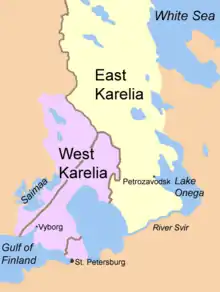East Karelia
East Karelia (Finnish: Itä-Karjala, Karelian: Idä-Karjala), also rendered as Eastern Karelia or Russian Karelia, is a name for the part of Karelia that since the Treaty of Stolbova in 1617 has remained Eastern Orthodox under Russian supremacy. It is separated from the western part of Karelia, called Finnish Karelia or historically Swedish Karelia (before 1808). Most of East Karelia is now part of the Republic of Karelia within the Russian Federation. It consists mainly of old historical regions of Viena and Aunus.

19th century ethnic nationalist Fennomans saw East Karelia as the ancient home of Finnic culture, "un-contaminated" by both Scandinavians and Slavs. In the sparsely populated East Karelian backwoods, mainly in White Karelia, Elias Lönnrot collected the folk tales that ultimately would become Finland's national epic, the Kalevala.
The idea of annexing East Karelia to Finland ("Greater Finland") was widely supported in newly independent Finland. It was especially popular during World War II when it seemed it could be done after a German conquest of the Soviet Union. Most of East Karelia was occupied by Finnish forces 1941–1944. The war was accompanied by hardship for the local ethnic Russian civilians, including forced labour and internment in prison camps as enemy aliens. After the Moscow Armistice, calls for annexation of East Karelia have virtually disappeared.
After Karelia was divided between Finland and Russia in 1918, the Finnic peoples that made up most of the population of East Karelia were promised far-reaching cultural rights. However, these rights were never realised and under Stalin ethnic Finns were persecuted and an intensive Russification programme began. Since the fall of communism, there has been a revival in Finnic culture in East Karelia.
External links
- Saimaa Canal links two Karelias, thisisFINLAND at the web-site of Ministry for Foreign Affairs of Finland
- Tracing Finland's eastern border-thisisFINLAND at the web-site of Ministry for Foreign Affairs of Finland